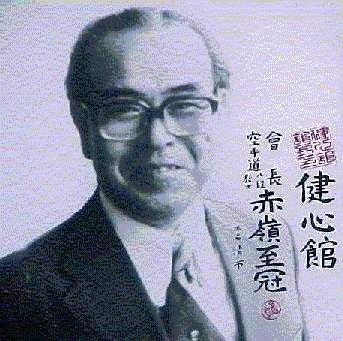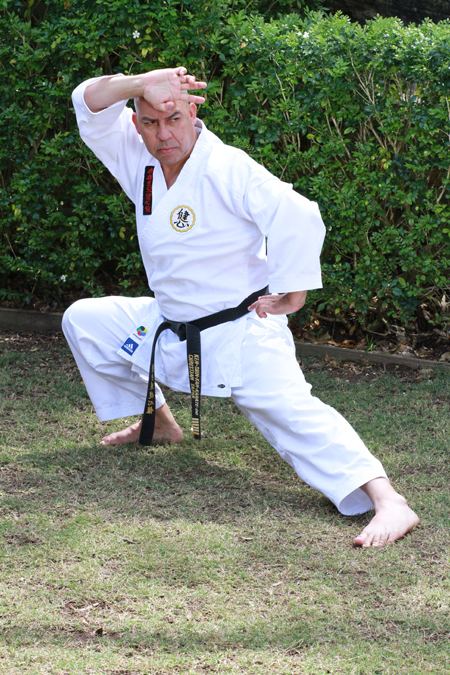Style Goju-ryu Karate Rank 8th dan karate | Name Seiichi Akamine | |
 | ||
Other names Shikan Akamine, Yoshitaka Akamine Notable school(s) Brazilian Association of Karate-Do, Ken-Shin-Kan Died July 18, 1995, Sao Paulo, Sao Paulo, Brazil Teacher Chomo Hanashiro, Kentsu Yabu, Chotoku Kyan, Kanki Izumigawa, Seko Higa | ||
Shihan Akamine Ken Shin Kan Chile
Seiichi Akamine (赤嶺 誠一, Akamine Seiichi, 14 May 1920 – 18 July 1995; also known as Shikan Akamine and Yoshitaka Akamine) was a Japanese master of Gōjū-ryū karate, a pioneer of the art in South America, and founder of the Ken-Shin-Kan Karate School which operates in various South American countries, the United States of America, Spain, and Australia. The school is also known as Kenshin-ryu or Shikan-ryu in parts of the world. Akamine was one of the most senior karate instructors to come to South America, holding the rank of 8th dan from the Dai Nippon Butoku Kai, and was the first Gōjū-ryū master in South America.
Contents

Early life

Akamine was born on 14 May 1920 in Izumizaki, Naha, Okinawa, Japan. He was the youngest of six brothers, and the only one of them to practise martial arts. He began training in the martial arts as a child under his paternal grandfather (who had been samurai), and later, more formally under Chōmo Hanashiro, Yabu Kentsū, and Chōtoku Kyan. Akamine practised Shuri-te until he met Chōjun Miyagi and devoted himself to the latter's Gōjū-ryū style.
Karate

Within the Gōjū-ryū fraternity, Akamine was most influenced by Sekō Higa (one of Miyagi’s senior students) and Kanki Izumigawa. He received promotion to the rank of 1st dan black belt in Gōjū-ryū at the age of 16, 2nd dan at 18, and 3rd dan at 20, all under Izumigawa. He was promoted to 4th dan at the age of 22, under Higa. Akamine also learned other arts, including Kanbun Uechi's Uechi-ryu style, Seitoku Higa's Bugeikan style, Seiken Shukumine's Gensei-ryu style, and kobudo (principally under Shinko Matayoshi). Akamine also learned various other Japanese martial arts and travelled to Fujian Province in China to learn kempo.
During World War II, Akamine was a telegraph operator in the Imperial Japanese Navy, serving in the Philippines. After the war, he settled in Itō, Shizuoka, on Honshu. He pursued university studies in anatomy and physiology, wishing to further his knowledge of healing arts that he had begun learning earlier.
Around that time, Akamine also opened a dojo (training hall), calling it "Shikan-Kan." He came to be known as “Shikan” Akamine, following his school's name, and also "Yoshitaka" Akamine. According to Fernando Prieto, the school was actually established as the Ken-Shin-Kan (健心館) but had to be renamed because there was another Japanese martial art school with the same name at the time. In October 1950, Akamine joined other masters for a Nippon Television karate show: Hidetaka Nishiyama represented the Japan Karate Association (Shotokan), Ryusho Sakagami the Itosu-Kai, Yasuhiro Konishi the Ryobu-Kai, H. Kenjo the Kenshu-Kai, and Izumigawa and Akamine the Gōjū-ryū.
South America
In either 1955 or 1957, Akamine was promoted to 8th dan by the Dai Nippon Butoku Kai. In 1957 or 1958, he moved to Brazil to seek a better life for his family and introduce martial arts into the country. He started work as a farmer, and an early attempt to teach martial arts in Paraná reportedly failed due to the poor character of the students. He established the Brazilian Association of Karate-Do in 1959 in São Paulo, but despite having an estimated 1,000 students, the school failed. Reportedly, he either left the association due to disagreement about its increasing emphasis on sport karate, or was removed due to political reasons.
In 1962 or 1968, depending on sources, he founded a new school, the Ken-Shin-Kan. Prieto claims that the school was named Ken-In-Kan in Brazil to avoid trademark infringements, but was otherwise known as Ken-Shin-Kan. According to Prieto, the Uruguayan branch of Ken-Shin-Kan was established in 1962, and expanded to Chile and Honduras after 1966. From 1971, in addition to teaching karate, Akamine accepted patients seeking massage therapy. Since its establishment, the school has also spread to Argentina, Paraguay, the United States of America, Spain, and Australia.
Later life
In 1988, Akamine apparently directed the Uruguayan branch to become independent, and later passed leadership of the Brazilian branch to his son-in-law, Hidekasu Oshiro. Akamine and his wife, Shizuko, had six children: Massahiko, a medical practitioner; Harehiko, a military official; Carlos Takeo, a university professor; Lucia Hisako, a homemaker (who married Oshiro); Ikuyo, a civil engineer; and Martha Massayo, a nutritionist. An avid numerologist, Akamine reportedly never accepted offers of promotion to 9th or 10th dan because he considered those numbers inauspicious.
Akamine died on 18 July 1995 in São Paulo, and was survived by his wife and children. Some of his belongings are on display in a museum in Brazil, and there is a memorial room dedicated to him in Uruguay.
